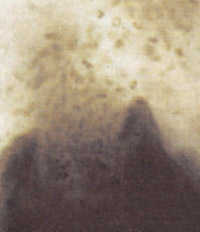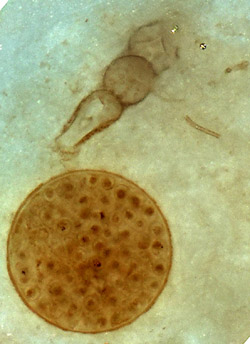Phenomenological approach to the
problem of chert formation
Vague ideas concerning chert formation are still
widespread, also in several textbooks on geology and petrology.
According to [1], cherts are formed by subsequent
silicification
of pre-existing rocks. This is certainly not true for most
fossiliferous
cherts, including the Lower Devonian cherts from Rhynie,
Scotland, and the Permian
cherts from Saxony, Germany.
Doubtless there is valuable work on various aspects of the problem in
the scientific literature but it would be virtually impossible for the
fossil collector or palaeontologist to dig himself through, separate
the valuable from the questionable, and arrive at a consistent view.
The concise compilation of facts combined into a chain of arguments
below is
meant as a help in this situation.
 Picture:
Quartz crystals growing in wood during an early stage of silicification
while everything else is soft. Apparently there is no strength left in
the wood as it is easily pushed aside by the growing crystals. Possibly
the wood is permeated
by silica gel which prevents the decay and collaps of the tissue. This
stage has
been preserved by the gel turning into chalcedony. Since the formation
of silicified wood is essentially similar to the formation of chert,
this sample serves as evidence contradicting the widespread view that
quartz comes last in the sequence of silicification stages.
Picture:
Quartz crystals growing in wood during an early stage of silicification
while everything else is soft. Apparently there is no strength left in
the wood as it is easily pushed aside by the growing crystals. Possibly
the wood is permeated
by silica gel which prevents the decay and collaps of the tissue. This
stage has
been preserved by the gel turning into chalcedony. Since the formation
of silicified wood is essentially similar to the formation of chert,
this sample serves as evidence contradicting the widespread view that
quartz comes last in the sequence of silicification stages.
Hence it seems always advisable to question established opinions.
Sample: Upper Carboniferous, Borxleben gravel pit,
Kyffhäuser mountains, Germany.
Thanks are due to W.+G.
Etzrodt, Borxleben, for providing
the sample.
1. There is ample evidence that some (possibly
most or all ?) fossiliferous cherts
went through a transient state
with the mechanical
properties of gel:
very low Young’s
modulus and fracture toughness,
as concluded from
the aspect
of early short cracks with wide opening and sharp tip,
later
filled with silica and now seen in the solid chert.
2. It is known that gel is made up of a
network with (liquid-filled) meshes
formed by weak bonds,
providing
easy diffusion
paths.
3. The transient state mentioned in (1)
could be realized as
- homogeneous silica gel,
- gel with disperse inclusions of opal, chalcedony, quartz,
-
aggregate of silica clusters behaving mechanically as a gel.
It is simply called gel
henceforth.
4. There is evidence that the formation
of most fossiliferous cherts via
gel
took place at or near the
surface but not in the depth.
5. There is evidence that coarse quartz
crystals can grow within a gel matrix
which is strong enough to
support
the weight of the crystal.
6. The quartz crystal growing within the
gel gets its SiO2 not
by dissolving the adjacent gel
since
otherwise it would slowly sink as it grows.
7. The growing
quartz crystal can give rise to crack formation in the gel.
8. From (2), (6) and (7) one may
conclude that the growing crystal obtains SiO2
by diffusion of
low-molecular dissolved silica through the gel network.
9. The source of silica
wandering through the gel
could be the same as for gel formation.
10. There are ranges of parameter sets
(silica
concentration, pH, salinity, temperature etc.)
where
silica solutions are supersaturated,
tending to gel formation.
11. Supersaturation is usually obtained via decreasing
temperature, which takes minutes to hours.
12. Supersaturation can be obtained
within seconds
by mixing of saturated or even
undersaturated solutions with suitable parameter combinations.
Such unexpected effect is due
to the non-linear dependence of solubility on parameters.
13. Quick mixing of fluids occurs in
surface flows, hence (11, 12) are compatible with (4).
14. Given (8) and (9), it can be assumed
that opal and chalcedony, too, can grow within silica gel
in
essentially the same way as quartz crystals do.
15. Finally the growth of precipitates results in a stage of
tightly
packed (micro-) crystals
with virtually no
gel left so that the solid chert is obtained.
 The
scenario outlined above can help to explain observations which seem
enigmatic. For example, sperm of the gametophyte of Aglaophyton is seen
in the Lower Devonian Rhynie chert at the instant of release from the
antheridium. When presented by H. Kerp
at the Rhynie Chert Conference
at
Aberdeen in 2003 [2], the question of how the sperm wriggling through
the
water could have been caught and preserved near the outlet remained
unanswered. Now it appears that quick supersaturation by mixing could
have done the trick. (The picture on the left is also given in [3] Fig.8.29
but with erroneous size data.)
The
scenario outlined above can help to explain observations which seem
enigmatic. For example, sperm of the gametophyte of Aglaophyton is seen
in the Lower Devonian Rhynie chert at the instant of release from the
antheridium. When presented by H. Kerp
at the Rhynie Chert Conference
at
Aberdeen in 2003 [2], the question of how the sperm wriggling through
the
water could have been caught and preserved near the outlet remained
unanswered. Now it appears that quick supersaturation by mixing could
have done the trick. (The picture on the left is also given in [3] Fig.8.29
but with erroneous size data.)

A similar case of quick gel formation, possibly within seconds, seems
to have spoilt the attack of a rotifer and preserved the scene for
eternity, as seen in this picture of the one and only rotifer known
from the Rhynie chert, first described in 2008, Rhynie
Chert News 23.
Photograph by H.
Eschrich, Jena.
Another piece of evidence for water turning into chert is provided by Rhynie
Chert News 123.
Some chert samples provide details of the sequence of events
during
silicification, as explained in Rhynie
Chert News 20,
27,
31, 59,
60,
64,
66,
Permian
Chert News 6, Fossil Wood
News 1
, 2. It
appears that silicification often involves processes known from agate
formation: deposition of silica linings along the walls of water-filled
cavities, precipitation of larger silica clusters which settle
into emulsions and make horizontal boundaries.
The silicification process can
be highly discontinuous, with repeatedly
alternating periods of isotropic and geopetal deposition, as explained
in Rhynie
Chert News 77.
H.-J. Weiss
2005, emended 2010, 2015,
2016, 2018
[1] R.
Rößler et
al.: Strandsteine
...
Veröff. Mus. Naturkunde
Chemnitz 30(2007), 5-24.
[2] H. Kerp, N.H.
Trewin, H. Hass : New gametophytes from the Early
Devonian Rhynie chert,
Trans.
Roy. Soc. Edinburgh, Earth Sciences 94(2004 for 2003), 411-428.
[3] T.N. Taylor,
E.L. Taylor, M. Krings : Paleobotany,
Elsevier 2009. (Warning: numerous erroneous size data.)
 Picture:
Quartz crystals growing in wood during an early stage of silicification
while everything else is soft. Apparently there is no strength left in
the wood as it is easily pushed aside by the growing crystals. Possibly
the wood is permeated
by silica gel which prevents the decay and collaps of the tissue. This
stage has
been preserved by the gel turning into chalcedony. Since the formation
of silicified wood is essentially similar to the formation of chert,
this sample serves as evidence contradicting the widespread view that
quartz comes last in the sequence of silicification stages.
Picture:
Quartz crystals growing in wood during an early stage of silicification
while everything else is soft. Apparently there is no strength left in
the wood as it is easily pushed aside by the growing crystals. Possibly
the wood is permeated
by silica gel which prevents the decay and collaps of the tissue. This
stage has
been preserved by the gel turning into chalcedony. Since the formation
of silicified wood is essentially similar to the formation of chert,
this sample serves as evidence contradicting the widespread view that
quartz comes last in the sequence of silicification stages. The
scenario outlined above can help to explain observations which seem
enigmatic. For example, sperm of the gametophyte of Aglaophyton is seen
in the Lower Devonian Rhynie chert at the instant of release from the
antheridium. When presented by H. Kerp
at the Rhynie Chert Conference
at
Aberdeen in 2003 [2], the question of how the sperm wriggling through
the
water could have been caught and preserved near the outlet remained
unanswered. Now it appears that quick supersaturation by mixing could
have done the trick. (The picture on the left is also given in [3] Fig.8.29
but with erroneous size data.)
The
scenario outlined above can help to explain observations which seem
enigmatic. For example, sperm of the gametophyte of Aglaophyton is seen
in the Lower Devonian Rhynie chert at the instant of release from the
antheridium. When presented by H. Kerp
at the Rhynie Chert Conference
at
Aberdeen in 2003 [2], the question of how the sperm wriggling through
the
water could have been caught and preserved near the outlet remained
unanswered. Now it appears that quick supersaturation by mixing could
have done the trick. (The picture on the left is also given in [3] Fig.8.29
but with erroneous size data.)